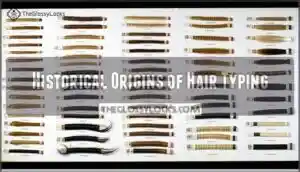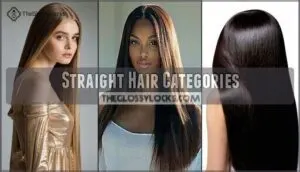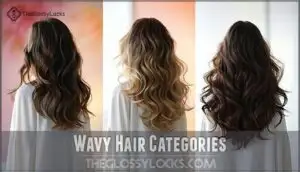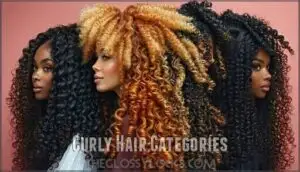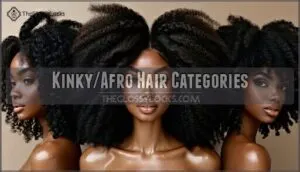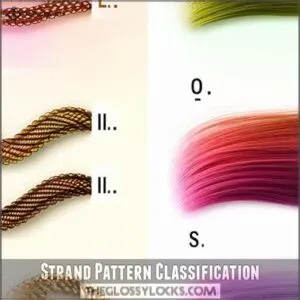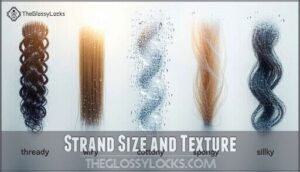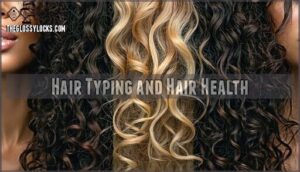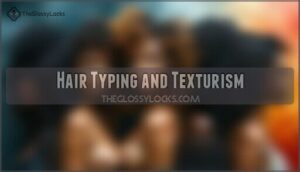This site is supported by our readers. We may earn a commission, at no cost to you, if you purchase through links.
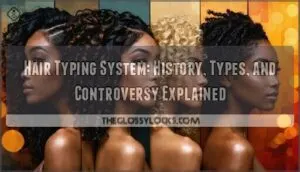
Andre Walker’s system, the most popular, divides hair into types: straight (1), wavy (2), curly (3), and kinky-coily (4), with subcategories for finer detail.
Another approach, the L.O.I.S system, focuses on strand shape, size, and thickness.
While helpful, these frameworks aren’t perfect—historically, they’ve sparked debates about racial bias and texturism.
Still, knowing your type can improve product choices and styling methods.
Curious about porosity, elasticity, or the controversial history behind it all?
These details might just reveal your hair’s potential.
Table Of Contents
Key Takeaways
- Hair typing systems, like Andre Walker’s and LOIS, help you identify your hair’s texture and curl pattern for better styling and care.
- The system’s roots in racial biases highlight its controversial history but stress the importance of embracing diversity and inclusivity.
- Factors like porosity and elasticity are just as important as hair type when choosing the right products and routines.
- Hair typing isn’t perfect, but it’s a tool to understand your hair’s needs and celebrate its uniqueness.
Historical Origins of Hair Typing
You mightn’t realize, but hair typing started with deeply flawed attempts to rank hair by its closeness to whiteness.
Tools like Eugen Fischer’s hair gauge and the Apartheid pencil test enforced harmful racial hierarchies.
Eugen Fischer’s Hair Gauge
Eugen Fischer’s hair gauge, introduced in 1905, was a tool of scientific racism, central to racial hygiene practices.
It classified hair into four categories, measuring texture to define proximity to "whiteness." Fischer’s methodology supported racial categorization, promoting harmful hierarchies.
- Historical Context: The gauge enforced Eurocentric ideals during colonial-era Namibia.
- Ethical Implications: It fueled eugenics and atrocities like bans on interracial marriages.
- Hair Typing System Roots: While today’s hair classification promotes inclusivity, its origins remind us of past injustices.
Apartheid Pencil Test
The Apartheid Pencil Test wasn’t just a quirky experiment—it symbolized racial discrimination at its peak.
A simple pencil slid through hair decided destinies, exposing the harsh realities of systemic racial discrimination.
Imagine this scenario: a pencil slid through your hair determined whether you were “white,” “coloured,” or “black,” dictating where you could live, whom you could marry, and your standing in society.
A stay or a slip carried immense social impact, splitting families and communities based on hair texture.
This test, grounded in a flawed obsession with racial categorization, became a stark reminder of how something as personal as hair was politicized.
While modern hair typing systems like Andre Walker or LOIS aim to empower and celebrate diversity, the historical context of the pencil test underscores the deep ethical implications of using hair for classification.
Hair politics matter.
Racial Categorization
Hair typing systems have a history that goes beyond beauty—it’s tied to racial bias and societal control.
In the 20th century, tools like Eugen Fischer’s hair gauge and the Apartheid Pencil Test used hair as a marker to enforce racial categorization. These methods weren’t really about hair; they were about power and exclusion, ranking individuals based on their proximity to whiteness.
Hair texture stereotypes played a major role in shaping identity and determining social status. The cultural impact of these practices is deeply rooted, influencing even today’s perceptions about beauty and acceptance.
- Hair typing systems were originally tools for discrimination, not care.
- Racial categorization fueled social divisions, creating long-lasting stereotypes.
- Afro-textured hair faced marginalization, linking texture to societal status.
- System evolution reflects progress, yet hair bias remains an ongoing challenge.
Despite progress, the shadow of discrimination still lingers.
Andre Walker’s Curl Typing System
You’ll find Andre Walker’s Curl Typing System is one of the most widely recognized methods for categorizing hair textures.
It organizes hair into four main types—straight, wavy, curly, and kinky—helping you understand and care for your unique hair type, using the Curl Typing System.
Straight Hair Categories
Straight hair, known as Type 1 in Andre Walker’s system, reflects light effortlessly, making it naturally shiny.
It ranges from fine and silky strands (1A) to thicker hair that resists curling (1C).
Managing straight hair depends on its texture and oiliness, which varies across subtypes.
| Hair Type | Texture | Key Traits |
|---|---|---|
| 1A | Fine Straight | Silky, thin, oily, hard to style. |
| 1B | Medium Straight | More body, easy to manage. |
| 1C | Thick Straight | Coarser, fuller, resists curling. |
Straight hair thrives with lightweight products and simple styling routines, making it essential to understand the key traits of each subtype to manage it effectively, and to keep it looking naturally shiny with the right care.
Wavy Hair Categories
Wavy hair, nestled between straight and curly types, is celebrated for its versatility and allure in the hair typing system.
Hair types 2A, 2B, and 2C each have unique patterns and challenges, but proper care highlights their beauty.
- 2A Specifics: Fine waves need lightweight products to avoid weighing down.
- 2B Characteristics: Defined waves benefit from frizz-fighting creams.
- 2C Challenges: Thick waves require intense moisture.
- Styling Wavy: Detangle gently with fingers or wide-tooth combs.
- Product Selection: Use hydrating leave-ins, curl creams, and sulfate-free shampoos. Many people explore options for specialized wavy products to enhance their hair.
Curly Hair Categories
Moving from soft waves to lively spirals, curly hair, or Type 3, showcases a variety of S-shaped curl patterns that radiate personality. Whether you have loose curly hair like 3A, with gentle loops, the springy definition of 3B, or tight curly hair as seen in 3C, every curl type has its unique charm.
Curly hair tends to be more porous, so it soaks up moisture but can struggle to retain it. Emphasizing hydration is essential to maintain elasticity and prevent frizz.
Proper product selection, like creams or gels designed for curl definition, can boost your curls’ bounce. Consider using specialized curl enhancing products for ideal results.
Incorporate styling techniques like "plopping" or diffusing for shape retention. With consistent care to prevent damage, your curly hair can stay vibrant, full of life, and effortlessly stunning.
Kinky/Afro Hair Categories
Type 4 hair, often called afro-textured or kinky hair, is a marvel of texture diversity.
Its tightly coiled strands are defined by beautiful Z-shaped patterns or compact spirals.
This hair type thrives on moisture but can face unique challenges like shrinkage, breakage, and dryness.
A deeper understanding of hair type subcategories can further refine your hair care approach.
Whether you’re caring for soft kinky hair (Type 4A) or moving from hair type 3C, coily haircare requires patience and the right products.
Afro empowerment starts with embracing your natural texture and prioritizing hydration, protective styling, and gentle handling.
Kinky styling is your chance to express creativity while nurturing strands that deserve nothing less than respect and love for their bold beauty.
The L.O.I.S Typing System
The L.O.I.S Typing System helps you identify your hair type by focusing on patterns, strand size, and texture.
It avoids the stigma of numerical labels, making it inclusive and easy to understand.
Strand Pattern Classification
The L.O.I.S hair typing system focuses on understanding your hair strand pattern with four distinctive categories:
- L: Strands with sharp bends, resembling fractured mountain paths.
- O: Perfect curl patterns shaped like circles, reflecting strands coiling tightly.
- I: Straight strands, lacking wave formation or curl definition.
- S: Wavy strands forming soft S patterns in their natural state.
This hair typing system celebrates hair patterns and curl patterns by emphasizing pattern uniformity, coil variety, and texture combination, helping decode your hair’s unique structure.
Strand Size and Texture
Your hair’s true identity isn’t just about curls—it’s also about its strand size and texture.
The L.O.I.S. hair typing system breaks textures down into five categories: thready, wiry, cottony, spongy, and silky.
Strand size adds to the uniqueness; fine hair feels delicate, while coarse hair is thicker and stronger.
Texture variations also depend on hair porosity—how well strands absorb moisture—and density, the number of strands on your head.
Understanding your hair type can help with selecting appropriate products for ideal hair health.
Here’s a quick guide:
Hair Typing and Hair Health
Your hair type isn’t just about looks—it affects how your strands react to moisture, heat, and products.
Understanding how porosity and elasticity tie to your hair type helps you make smarter choices for healthier, more resilient hair.
Predicting Chemical Interactions
Understanding your hair’s type isn’t just an aesthetic endeavor—it’s chemistry in action. A hair typing system guides product absorption and damage prediction by explaining how different textures interact with chemicals.
Here’s how to guarantee the best treatment outcomes:
- Match products to your texture for ideal chemical compatibility.
- Pay attention to porosity effects for accurate results.
- Consider how hair chemicals may impact integrity long-term.
- Predict hair reactions to chemicals based on curl patterns.
- Tailor hair treatments to avoid adverse chemical reactions.
Science meets self-care! Overgrowth of yeast can cause dandruff and itching.
Hair Porosity and Elasticity
In the context of your hair’s behavior, porosity levels and elasticity factors are key players.
Porosity decides how your strands soak up and lock in moisture—high porosity hair drinks quickly but leaks moisture, leading to dryness or damage.
Elasticity measures your hair’s bounce-back ability; healthy elasticity means less hair breakage during stretches.
Product absorption and moisture retention depend on these traits.
Recognizing your hair’s porosity and elasticity helps in damage assessment, guiding you to avoid products or habits that weaken your hair.
Addressing porosity issues may require specialized hair care products.
Hair Typing and Texturism
You’ve probably noticed how certain hair types often get more praise, while others seem overlooked or criticized.
This is where texturism comes in, highlighting how hair typing systems can sometimes reinforce biases about which textures are deemed “ideal” or more acceptable.
Criticism and Favoritism
Criticism surrounding hair typing systems often highlights how they unintentionally reinforce biases.
These systems frequently favor looser curls over coily textures, creating a hierarchy that fuels texturism perpetuation.
This bias in classification leaves many with afros and tightly coiled hair feeling excluded or undervalued.
When paired with beauty marketing, hair favoritism grows worse, subtly reinforcing societal preferences for specific textures.
Coily hair, which should be celebrated for its versatility and beauty, often faces neglect in product representation and care guides.
These system limitations create gaps in inclusivity promotion and hair texture discrimination persists, both socially and commercially.
A key factor is understanding hair’s strand diameter, as it influences product needs.
It’s essential to see hair typing as a guide, not a rulebook.
By recognizing these flaws and questioning hair bias in classification, we can shift toward systems that honor all textures equally, breaking the cycle of hair texturism perpetuation for good.
Impact on Social Perception
Bias surrounding hair types runs deeper than you might think.
Hair type biases shape beauty ideals, impacting self-esteem, cultural identity, and how we define professionalism across society.
Straight or wavy hair often aligns with traditional beauty standards, promoted through media representation, while coily and kinky hair textures face hair discrimination.
These perceptions aren’t just about looks; they shape self-esteem, social interactions, and even career opportunities. Take workplace discrimination—natural curls or protective styles can be perceived as unprofessional, reflecting a long history of texturism.
Cultural identity ties are also affected when natural hair is treated as less desirable or manageable. This impacts anyone coping with hair texture discrimination, often pushing individuals to alter their hair.
Yet, celebrating your hair’s uniqueness can challenge outdated norms. Movements on platforms like Instagram encourage embracing diverse textures, rewriting hair’s social significance. Overcoming hair bias starts when you view your natural texture as a symbol of authenticity and pride.
Frequently Asked Questions (FAQs)
What are the different hair typing systems?
Hair typing systems, like Andre Walker’s or LOIS, sort hair by curl patterns, strand size, and texture.
They help you choose products and styling methods by understanding straight, wavy, curly, or coily types better.
How does hair typing influence product development?
Understanding your hair type helps brands craft products suited to specific needs, like moisture for coily hair or lightweight formulas for fine strands.
It’s science meeting beauty, ensuring better results and happier hair days, with complete concepts like these leading to more effective hair care.
Can hair types vary across different climates?
Imagine this scenario: you’re in a tropical climate, and your once-sleek hair now frizzes up.
Yes, hair types adapt!
Climate impacts moisture levels, causing shifts in curl patterns, texture, and even manageability over time.
What role does diet play in hair health?
Your diet fuels hair growth, so eat a mix of protein, vitamins, and healthy fats.
Iron and biotin boost strength, while omega-3s keep strands shiny.
Hydrate! Dry hair’s a thirsty strand’s cry.
How can humidity impact various hair types?
Humidity makes straight hair limp, boosts frizz in wavy to curly textures, and shrinks coily hair.
Moisture in the air disrupts your hair’s structure, so choose anti-humidity products or protective styles to manage effects.
Are there regional differences in hair texture trends?
Regional differences in hair texture trends often reflect climate, genetics, and cultural practices.
Tropical areas see frizz-prone textures due to humidity, while colder regions favor straight styles.
Local hairstyles and traditions also shape hair care routines, influenced by genetics and other factors.
Conclusion
Knowledge is power, and understanding the hair typing system can help you release your hair’s full potential.
While no framework is perfect, learning your type—be it straight, wavy, curly, or coily—guides you toward better care routines, product choices, and styling techniques.
Remember, hair typing isn’t just about structure; factors like porosity and elasticity matter too.
Awareness of the system’s history and controversies adds depth to its use, making it a tool for empowerment, not limitation.

